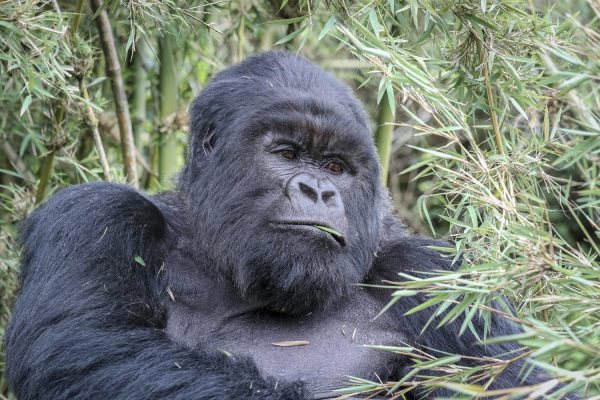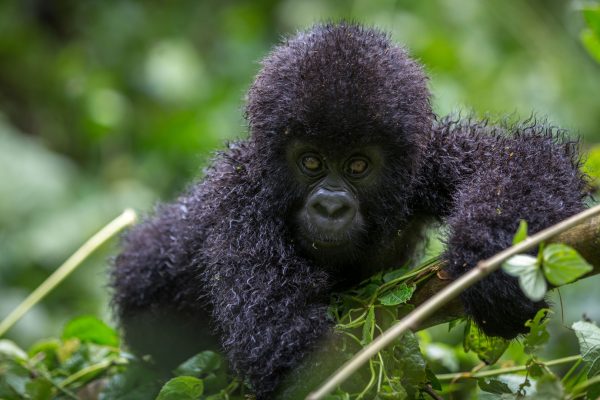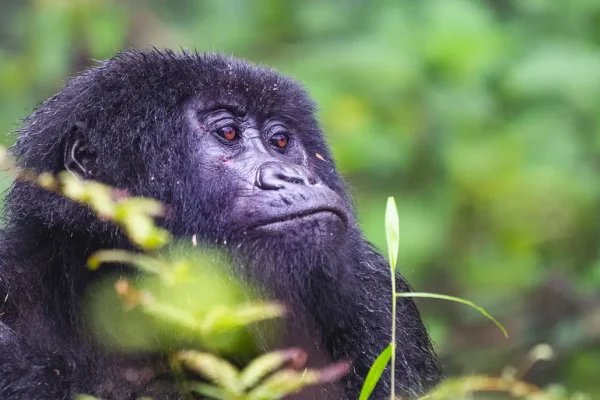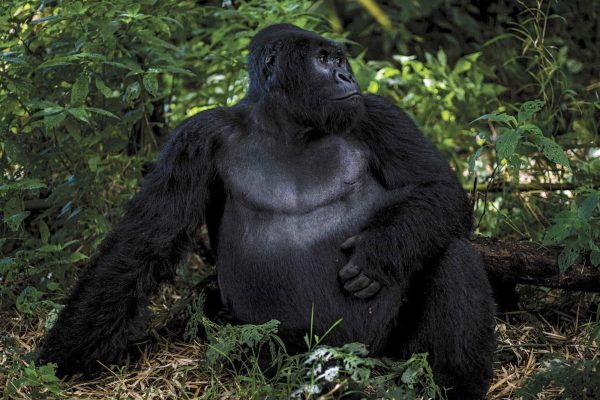Private Gorilla Trekking Tours for Small Group like Couples, Families, Friends
Our gorilla trekking tours for small group allow you to join other travelers in exploring Uganda, Rwanda, Kenya, and Tanzania in a fun and reasonable manner. Kabira Safaris has evolved into a small group gorilla trekking tour company, with multiple groups departing for various trips on a weekend and monthly basis.
A unique chance to witness our closest living animal ancestors in their natural rainforest homes.
There are only two populations of mountain gorillas left in the world. One is in the Virunga volcanic highlands of Central Africa, with groups spread out across Rwanda’s Volcanoes National Park. The other is deep in Uganda’s Bwindi Impenetrable Forest. With our gorilla trekking experiences, you can get up close and personal with these amazing animals. The excursions can be hot and muddy because you’re in the jungle, but once you see a majestic silverback or a mother with her cheeky kid, all the work will be worth it.
Note: we highly recommended our Gorilla Trekking Tours for Small Group like Couples, Families, Friends.
Gorilla Trekking Tours for Small Groups
Our gorilla trekking tours for small group give you an up-close and personal encounter with African nature and wildlife. You will travel through Africa’s magnificent regions in a bespoke 4×4. Depending on the excursion, group numbers can range from 4 to 16 travellers. The majority of the tours on a small group safari demand some participation.
Where we trek
Kabira Safaris can take you to either of the last two populations of mountain gorillas in the world. The first group resides in Rwanda’s Volcanoes National Park, and the second group lives in Uganda’s Bwindi Impenetrable Forest. What are the distinctions you may expect between the two?
Gorilla Trekking in Volcanoes
Rwanda’s Volcanoes National Park is home to twelve habituated gorilla households. The terrain you will traverse in Rwanda may be comparatively less dense and more open than that of Uganda, leading some individuals to perceive it as a more manageable journey. The park is well-established, features robust infrastructure, is a mere three-hour drive from the international airport, and offers nearby decent accommodations. The gorilla trekking permit in Rwanda is considerably pricier than in Uganda.
Gorilla Trekking in Bwindi
Ten habituated families exist in Uganda’s Bwindi Impenetrable Forest. It typically receives more precipitation than Rwanda, resulting in potentially treacherous terrain and a more challenging trek. This park is relatively undeveloped and is around a twelve-hour drive from the international airport. The gorilla trekking permit in Uganda is approximately fifty percent less expensive than that in Rwanda, rendering it a more appealing choice for budget-conscious travellers.
Gorilla Trekking Africa
The three greatest nations in the world for a luxury gorilla trekking Africa/Gorilla Safaris. In the Gorilla Trekking Africa sector, Uganda, Rwanda, and Congo have established themselves as the top locations for tourists looking to go on Luxury Gorilla Trekking Africa, and walk through wild, pristine jungles in quest of these elusive primates. For those who have had the honor of taking advantage of this once-in-a-lifetime chance, seeing mountain gorillas in their natural environment is reported to be a life-altering and eye-opening event that has become an indelible memory.
Congo Gorilla Trekking
We have well-customized packages that offer short Congo Gorilla tours to Virunga National Park for mountain gorilla trekking or to Kahuzi-Biega National Park for Lowland Gorilla tracking. Check out these packages or talk to us for advice on Short Gorilla Safaris in Congo. Congo Gorilla Trek in Virunga National Park & Kahuzi Biega Park. Book Best Congo Gorilla Trek Tour Safaris Packages & Gorilla Permits Price. Gorilla safaris in Congo (DRC) are particularly special as this is the only country in the world inhabited by both mountain and lowland gorillas.
FAQs: Private Small Group Gorilla Trekking Tours
How fit do I need to be to trek to see the gorillas
You must be sufficiently fit to hike to the habitat of your family of mountain gorillas. This may entail walking for one to six hours in hot and humid circumstances, across hills and dense tropical forest. Mud may be present underfoot, rendering the walk slippery. However, do not allow this to deter you—the final outcome is worthwhile.
During the pre-trek briefing, participants will be categorized into groups of eight according to their age and physical fitness. The rangers often possess a comprehensive understanding of the locations of each gorilla family group and the anticipated trekking duration for each group. The fitter groups will journey to families in more arduous regions or over greater distances.
Can I hire a porter to help me
You are need to transport your personal belongings for this journey, including water, a rain jacket, and cameras; but, you may certainly engage a local porter for assistance. Engaging a porter for a gorilla walk is a prevalent practice among travelers of various ages and capabilities. The porters will transport your backpack and assist you in traversing the more challenging or steep segments of the walk.
It facilitates your journey while simultaneously generating a significant source of revenue for local residents. Engaging a local porter is economically feasible; ensure you enquire with your trip leader regarding porters prior to the trek.
How long do I get to spend with the gorillas
Upon locating your gorilla family, you are allotted one hour in their presence. This aims to reduce the likelihood of disruption or illness transmission to the animals. A maximum of eight individuals may visit any single habituated family each day.
Is there a chance I won’t see the gorillas on my trek
While it is not absolutely certain that you will encounter gorillas, it is exceedingly rare not to do so. Gorilla trackers depart at dawn daily to identify gorilla families and transmit the coordinates back to headquarters. This indicates that prior to commencing your journey, the trackers had a substantial understanding of your family’s current or anticipated location.
How do I arrange a gorilla trekking permit
Permits are encompassed in the price of Kabira Safaris’ gorilla trekking tours, and we will obtain the permit on your behalf upon receipt of your trip fee. Currently, we only require your passport information. On certain excursions, travelers may have the chance to trek and observe the gorillas a second time. These supplementary permissions should be arranged prior to departure during the booking process.
Can I opt to trek a second time on the trip
During our excursions, there is frequently an opportunity to undertake an optional supplementary hike to observe the mountain gorillas. A certain quantity of permits is allocated daily for each gorilla family; thus, we advise pre-booking your hike and permit via your booking agent to prevent disappointment, particularly during high season.
Can I request to trek with a specific gorilla family
At the briefing, it is feasible to request to trek with a certain gorilla family; however, this cannot be assured.
What’s the age limit for trekking to see the gorillas
According to national park regulations, individuals must be at least 15 years of age to trek for gorilla viewing in Uganda or Rwanda.
What’s the best time to trek to see the gorilla
Gorilla trekking is available throughout the entire year. The arid season occurs from June to September and December to February, whereas the precipitation season spans March to May and October to November. The rainy season complicates trekking, prompting many individuals to choose the dry season for their excursions. It is essential to acknowledge that you are traversing tropical rainforests, where precipitation is prevalent year-round, irrespective of the season.
What if I’m not feeling well on the trek
Your ranger will provide you with essential instructions and regulations for gorilla trekking before to your expedition. If you are unwell or have a contagious illness, we advise you to remain at home, and an alternative appointment will be scheduled for you. Gorillas are vulnerable to the transmission of pathogens and illnesses, potentially endangering their health. At now, the use of masks is mandatory throughout all gorilla trekking tours.
Will I be trekking with my Kabira Safaris group
A maximum of eight individuals may visit a single habituated family each day, which may result in your group being divided into smaller trekking parties. Subject to permit availability and party size, you may have the opportunity to trek on two separate days.
Do I need special equipment or clothing for my trek
Monitoring gorillas in the deep jungle can occasionally be damp, muddy, and uncomfortable. A comfortable pair of waterproof hiking boots or shoes is essential. Certain flora in the forest possesses sharp spikes and can be thorny; therefore, a gardening glove with a reinforced palm will facilitate gripping trees and bushes while ascending the hillside. It is advisable to take a pair of long socks to tuck your trousers under, so preventing ants or insects from reaching your ankles. Lightweight, long-sleeved shirts will safeguard your arms while remaining cool. A hiking pole can be obtained at your local resort or the hike headquarters. A compact backpack for transporting a camera, personal belongings and a water bottle is advisable.
Is gorilla trekking dangerous
Treks are exclusively undertaken among ‘habituated’ gorilla populations. A gorilla family need approximately two years to acclimatize to humans. To guarantee the safety of travelers during trekking, established rules and regulations must be adhered to at all times. You will receive a briefing on these matters before to your departure in pursuit of your designated habituated gorilla family. During the trip, the accompanying park ranger will guarantee compliance with the regulations.
Do your guides carry first aid kits
All gorilla treks are conducted by highly trained national park guides, rangers, and trackers. The ranger or lead guide possesses a first aid kit and will deliver an extensive safety briefing at the commencement of each hike.
How we’re giving back
Participating in a gorilla hike in Uganda or Rwanda substantially aids mountain gorilla conservation initiatives. The mountain gorilla population in the Virunga Mountains has increased markedly over the past decade, primarily thanks to the conservation initiatives funded by travelers acquiring gorilla trekking trekking permits. The increase in population is attributed to the implementation of park rangers, veterinary services, community assistance initiatives, and regulated tourism. When combined with an independent population of mountain gorillas residing in Bwindi Impenetrable National Park in Uganda, the total number of mountain gorillas exceeds 1,000 individuals.





